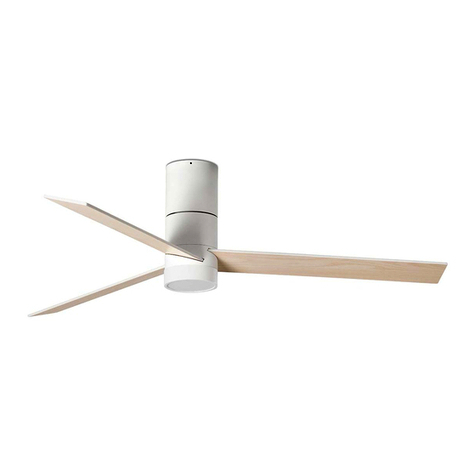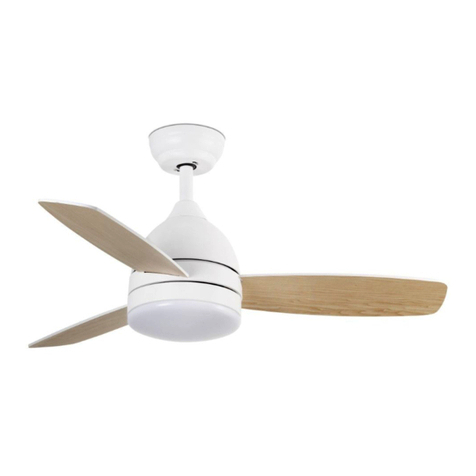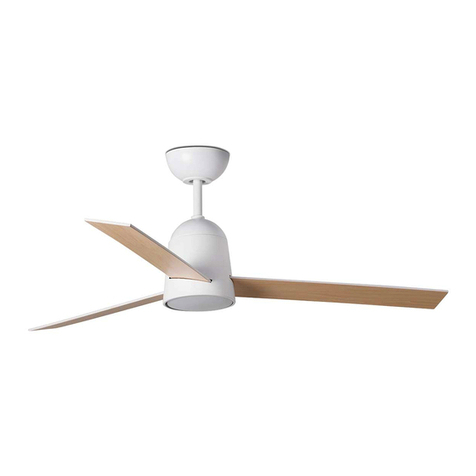
a la estructura de soporte del edificio de acuerdo con estas instrucciones y
use solamente los herrajes suministrados.
Para evitar un posible choque eléctrico, antes de instalar su ventilador de-
sconecte la electricidad, apagando los interruptores de circuito o disyun-
tores que alimentan la caja eléctrica donde se va a instalar al ventilador y el
interruptor de pared asociado.
Para la conexión eléctrica es preciso incorporar un interruptor seccionador
de acuerdo con las reglamentaciones de instalación, que asegure el corte
omnipolar, directamente conectado a los bornes de alimentación y debe
tener una separación de contacto en todos sus polos, que suministre de-
sconexión total bajo condiciones de sobretensión de categoría III.
Todos los procedimientos de conexión eléctrica e instalación deben cumplir
con los códigos eléctricos nacionales y códigos locales. El ventilador de
techo debe estar conectado a tierra a fin de prevenir posibles descargas
eléctricas. La instalación eléctrica debe ser llevada a cabo o aprobada por
un electricista autorizado.
Asegúrese de no dañar el cableado eléctrico de la red al taladrar el techo.
Los cables eléctricos no se pueden nunca torcer o grapar entre el ventilador
y la superficie de soporte.
Asegurarse de que el ventilador está desconectado de la alimentación an-
tes de quitar la protección.
Para reducir el riesgo de lesiones personales, no doble el sistema de fi-
jación de las palas cuando instale, equilibre o limpie el ventilador. Nunca
inserte objetos extraños entre las palas del ventilador cuando este girando.
Para reducir el riesgo de incendio, choque eléctrico o daños al motor, no
levante ni cargue el ventilador sosteniéndolo por los cables eléctricos.
ATENCIÓN: Si detecta un movimiento insólito oscilante del ventilador, pare
el ventilador inmediatamente y póngase en contacto con el fabricante, su
agente de servicio o personas adecuadamente calificadas.
El montaje y reemplazo del sistema de suspensión de seguridad debe ser
realizado por el fabricante, su agente o personas adecuadamente califica-
das.
El sistema de fijación al techo deberá soportar como mínimo 4 veces el
peso del ventilador.
Las palas del ventilador no pueden quedar a una altura menor de 2,30m /
7.54 pies sobre el suelo.
No monte el ventilador sobre superficies húmedas, recién pintadas o que
presenten conductividad eléctrica.
Las luminarias sin protección especial contra la penetración de polvo o hu-
medad (sin marca IP) sólo son aptas para uso en interior, donde el contacto
con el agua y la humedad sea imposible.
Las luminarias con módulos LED deben posicionarse de tal manera que no
estén expuestos fuentes de calor.
Las instrucciones y las normas de seguridad contenidas en el presente
manual no pueden prevenir todas las condiciones y situaciones que pudi-
eran presentarse. Por razones obvias, el presente manual no puede incluir
factores como la precaución y el cuidado. Estos factores deberán ser asu-
midos por la(s) persona(s) que instalan, mantienen y utilizan el producto.
Nuestros ventiladores cumplen con las normas de seguridad vigentes.
La manipulación interna o externa de la luminaria puede comprometer su
seguridad. El fabricante no asume las responsabilidades derivadas del uso,
manipulación y montaje incorrectos realizados por el usuario.
Nuestros productos están sujetos a cambios técnicos u optimizaciones, por
ello no nos responsabilizamos que toda la información técnica este actu-
alizada. En caso de preguntas, no dude en llamar a nuestro departamento
técnico.
Importante
Tensión nominal (V): diferencia de potencial eléctrico (voltaje) entre dos
puntos. Esta tensión no debe superar la marcada en el ventilador.
Hz: Frecuencia nominal mide el número de repeticiones por unidad de tiem-
po (Hercio). Esta frecuencia no debe superar la marcada en el ventilador.
Intensidad de la corriente (A-Amperio) es el flujo de carga eléctrica que
recorre un material.
Potencia nominal (W) es la potencia máxima que demanda el ventilador a
las diferentes velocidades, en condiciones de uso normales.
Número de giros del ventilador dependiendo de la velocidad seleccionada
(RPM).
Air flow (CFM/ m3min) Flujo de aire del ventilador
DC motor: El ventilador funciona a corriente continua, a la misma tensión
(corriente directa).Se caracteriza por su bajo consumo (hasta 70%menos),
funcionamiento silencioso, un control preciso de la velocidad, rapidez para
las acciones de arranque, aceleración, desaceleración y paro, amplio rango
de velocidades, és más ligero y eso facilita la instalacióny no se calienta.
CONSEJOS DE INSTALACIÓN
Para sacar el máximo partido y garantizar la durabilidad de su venti-
lador debe elegir correctamente el tamaño del ventilador en función de
la habitación donde lo vaya a instalar, respetar la distancia de seguridad
(2,3m-90.50inches) entre el ventilador y las superficies, objetos o personas
cercanas.
La superfície donde va a instalar el ventilador y el soporte de fijación debe
ser capaz de soportar 4 veces el peso de este (kilos - libras).
En instalaciones de más de un ventilador asegure la distancia mínima de
2,30 metros entre las aspas de los diferentes ventiladores.
MANTENIMIENTO
Importante! Antes de realizar cualquier tarea de mantenimiento asegúrate
que has desconectado la corriente eléctrica desde el circuito principal.
Debido al movimiento natural del ventilador, algunas conexiones podrían
soltarse. Revisa las conexiones, los soportes y las fijaciones de las palas
dos veces al año para asegurar que siguen firmes.
No es necesario engrasar el ventilador. El motor tiene rodamientos lubrica-
dos permanentemente.
El ventilador se tiene que limpiar con un paño suave y húmedo, evitando
el contacto de líquidos con las partes eléctricas. Utiliza un detergente de
pH neutro.
Nunca limpies el ventilador con sistemas a presión.
Utiliza solamente un paño suave para evitar rayar el acabado.
GUÍA DE LOCALIZACIÓN DE AVERÍAS
Importante! Antes de realizar cualquier revisión asegúrate que has de-
sconectado la corriente eléctrica desde el circuito principal
El ventilador no arranca
1. Revisa los circuitos principales y secundarios, asegúrate que están en-
cendidos.
2. Revisa las conexiones en el bloque de terminales según lo indicado en
la instalación.
3. Asegura que has quitado las lengüetas estabilizadoras del motor.
4. Si el ventilador todavía no funciona, llama a un electricista cualificado.
No trates de reparar las conexiones eléctricas internas sin tener experiencia
para hacerlo.
El ventilador hace ruido
1. Asegura que todos los tornillos están apretados.
2. Comprueba que el embellecedor esté bien colocado, tocando al techo.
3. Permite un periodo de asentamiento de 24 horas. La mayoría de los
ruidos asociados con un ventilador nuevo desaparecen después de este
periodo.
La luz no se enciende (cuando hay kit de luz)
Revisa las conexiones del kit de luz. Si el kit de luz todavía no funciona, pide
ayuda a un electricista cualificado.
El ventilador se balancea
1. Asegúrate que la bola de suspensión del ventilador está bien asentada y
que los soportes de montaje estén firmemente apretados a la viga del techo.
2. Verifica que el espacio entre las palas y otros objetos es el adecuado.
3. Revisa que todos tornillos están bien apretados. Confirma que los
soportes de las palas y las palas están correctamente colocados.
4. Verifica que la altura de todas las palas al techo es la misma. Si detecta
que alguna es diferente coloca una arandela, no suministrada, entre la pala
y el soporte, en el tornillo más cercano al motor, para ajustar esta distancia.
5. Si aún así no se ha corregido el balanceo, intercambia dos palas adya-
centes para redistribuir el peso. El funcionamiento será más suave.
6. En caso de que continúe la incidencia, utiliza el kit anti-balanceo que se
suministra, de la siguiente manera:
En la pala que notas el
balanceo, con el ventilador
parado, fija una grapa (1)
en el borde de la pala, en-
tre la punta y el soporte.
Pon en marcha el ventilador, para ver si se ha solucionado. En caso con-
trario desplaza la grapa (1) hacia el motor o hacia a punta. Prueba hasta
que encuentres la posición donde haya menos balanceo. Una vez localizada
la mejor posición coloca el peso (2) en la línea que te marca el clip hacia
el centro de la pala. Recuerda quitar el papel que cubre el adhesivo. Esto
debería corregir el balanceo. En caso contrario repite el proceso y añade
otro peso.
SIMBOLOGIA
RF
1- Toma de tierra (cable amarillo/verde) que debe ser conectado al clip
marcado con el símbolo.
2- Ventilador de uso exclusivo para interiores, en habitaciones donde el
contacto con el agua y la humedad sea imposible.
3- Comandament a distància amb ràdio freqüència. Emet ones al receptor.
4- Función Inversa: El ventilador tiene la posibilidad de cambiar la dirección
de rotación de las palas y así optimizar el movimiento del aire.
FR Lisez tout ce manuel soigneusement avant de commencer l’installation
et gardez ces instructions. Notre service technique se tient à votre entière
disposition pour toute information.
Veuillez toujours prendre en compte toutes les spécifications de l’appareil
figurant sur l’étiquette grise collée sur la lampe et sur le document du sché-
ma d’installation.
Sortez le moteur du carton d’emballage. Pour éviter de rayer la finition, as-
semblez le moteur sur une surface douce matelassée ou utilisez la mousse
du boîtier moteur. Ne posez pas le ventilateur sur le côté pour ne pas détéri-
orer la finition décorative.
Warning Atención Attention



































